Dr Manuel Esperon-Rodriquez helping to install a Living Lab
Authors: Paul Rymer, Manuel Esperon-Rodriquez and Allison Hewitt, 22nd November 2021
What is a Living Lab? The Living Lab involves the establishment and monitoring of new urban planting sites to evaluate plant performance across a wide range of environmental conditions and the associated environmental benefits that underpin healthy urban environments. They will measure how selected species of trees and shrubs perform in real-world settings over time in different states across Australia. A Living Lab allows researchers, industry, government, and communities to collaborate around a dedicated space. To learn more about the Living Labs, see the brochures below and read our blog post ‘Lessons from our Living Labs’.
Living Labs brochure (PDF, 706 KB)
Living Labs planting protocol (PDF, 2.95 MB)
Below are short posts documenting the installation of Living Labs around Australia.
Living Lab established at Western Sydney University Hawkesbury Campus
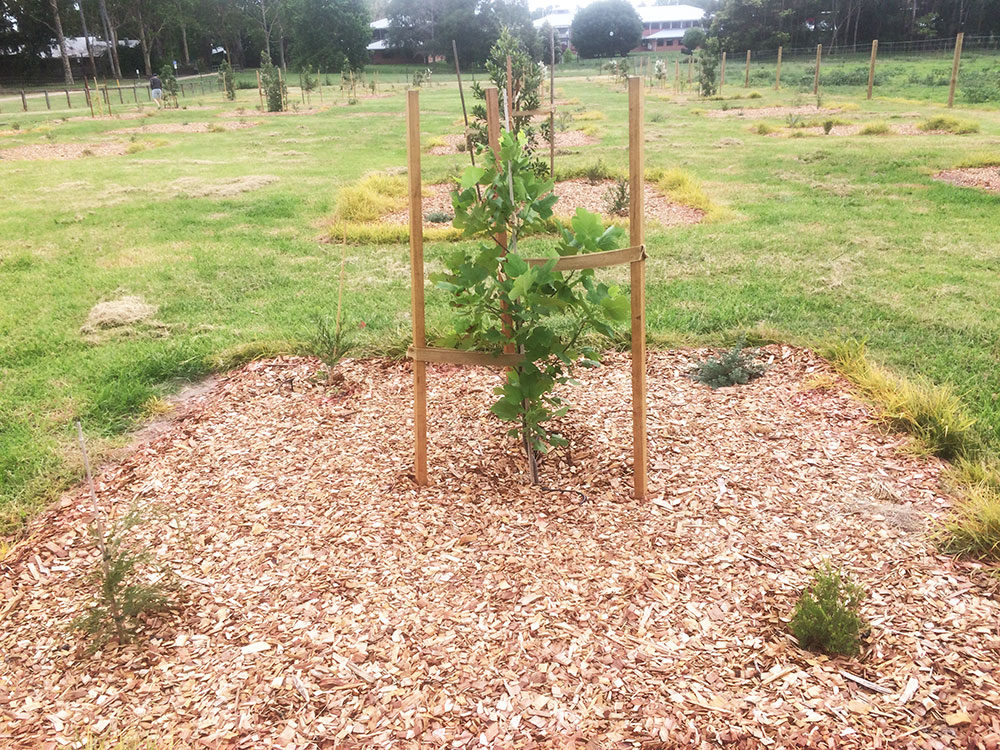
Established deliberately at the hotter and drier end of the Sydney climate spectrum, the Hawkesbury Campus Living Lab yields data on how commonly planted street trees and shrubs are coping under warmer temperatures including last summer’s heatwave conditions.
New data collection by Dr Manuel Esperon-Rodriguez of Western Sydney University has employed methods to measure responses to heatwaves and drought during the hot summer period.
At this site, researchers are conducting a detailed assessment of species’ performance under harsh climate conditions. By measuring different growth and physiological responses and functional traits, this site will provide information on how species respond, adapt and survive heatwaves and drought events.
Additionally, the Living Lab will provide information in regards to how different cooling benefits provided by the species influence insect biodiversity.
The City of Newcastle partners to track climate tolerances for street trees
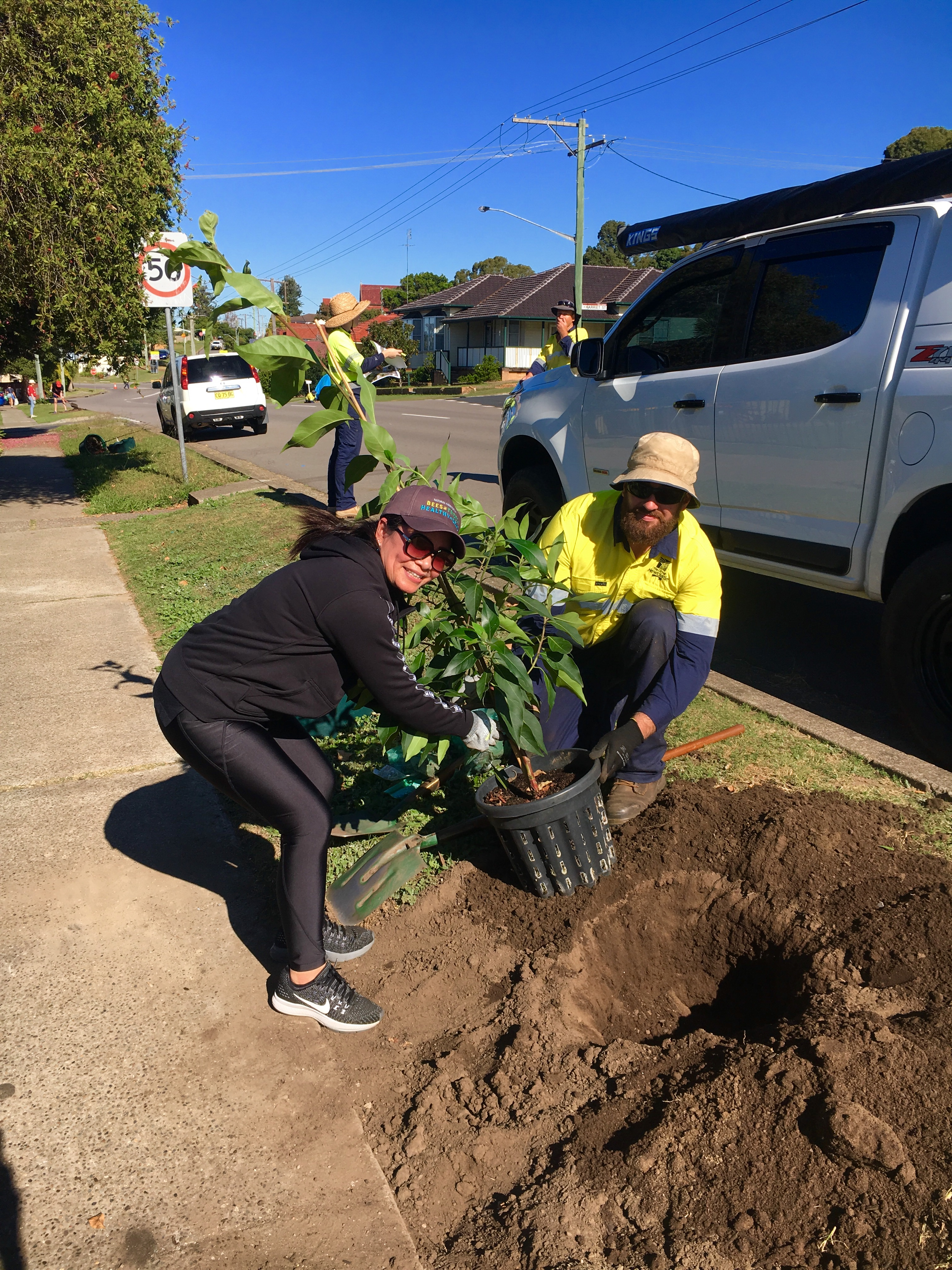
The national Which Plant Where project is a collaboration that aims to quantify the climate tolerances and co-benefits of planting landscape species of shrubs and trees in our urban spaces and to assist in species selection for future urban settings.
The Living Lab tree plantings in Newcastle build on Newcastle’s solid work in the urban forest space since the adoption of council’s Urban Forest Policy in 2008.
“The data collected in Newcastle is assisting researchers to disentangle the factors at play in successful urban plantings,” says Postdoctoral Researcher Dr Manuel Esperon-Rodriguez.
Newcastle’s Living Lab will be tracked over several years by researchers from Western Sydney University and Macquarie University and will add to the data already held in City of Newcastle’s comprehensive tree inventory database.
New Living Lab in Sydney’s Inner West
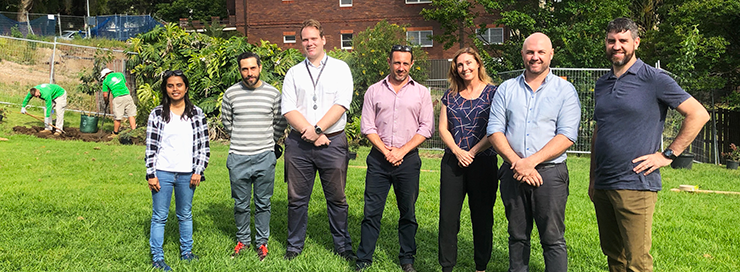
A changing climate has ramifications across the whole of the horticulture sector, but in particular for the nursery industry, where the commercial objective is essentially to sell healthy plants that remain healthy into the future. This is what is being addressed by the research project, “Which Plant Where?”, undertaken by Macquarie University and Western Sydney University, and proudly supported by Hort Innovation’s Green Cities Fund (as part of its recently developed Hort Frontiers initiative).
This collaborative project is testing a range of plants under various climate conditions to gain a better understanding of what species are going to thrive in a hotter future and which will not. Building on this work, the team will create an online tool that will identify suitable plants for specific urban areas across Australia.
The research has implications for a range of applications, from everyday gardeners who want to make sure their gardens flourish, to larger scale urban precincts where plants will provide cooling and shading for residents. Recently, Sydney’s Inner West Council got on board and have now planted the project’s first “Living Lab”, where specifically chosen plants will be monitored in real-life urban settings.
For this first experiment, Inner West Council has provided an area in Underwood Reserve, Summer Hill, where a range of trees and shrubs have been planted in the popular community space. Researchers will monitor plant performance as well as the associated environmental benefits.
The Inner West council plants around one thousand trees a year, and Gwilym Griffiths, Urban Forest Manager for the Council, says it’s crucial that plant choice takes into consideration the long-term. “Urban areas are highly contested spaces, so we need to get it right,” he said at the Living Lab’s launch.
“The challenges are only going to increase, with increased heat and the further development of urban areas, so when we plant trees we really need to make sure we’re maximising their success. In partnering with ‘Which Plant Where?’ we hope to achieve this maximisation. We want to make sure that the trees we’re planting are the right trees, and that they’re resilient for the future.”
While the core of the research is to understand how plants will endure in a changing environment, the project extends beyond merely their survival. As Western Sydney University researcher, Paul Rymer, explained.
“We have developed the Living Lab to measure the co-benefits plants provide. It will allow us to closely examine what benefits trees provide to the canopy and how shrubs support soil structure. Further, we will measure the difference between basic and complex combinations so we can get a better understanding of the different benefits they provide. By capturing this information we can provide growers, Councils and the general public information about the best combination for capturing pollutants, increasing urban cooling and soil health, and supporting biodiversity.”
The Living Lab in Summer Hill leads the way for other on-ground collaborations to come. The ‘Which Plant Where?’ Project Manager, Leigh Staas, says “Living Labs are a really fantastic way for our researchers to collaborate with end users. What we’re really trying to do is create confidence for growers and practitioners, by providing evidence-based research of how a plant performs across urban landscapes to growers and nurseries. This means growers can better plan what plants they’re producing in the nurseries and putting into our urban landscapes.”
Sunshine Coast Council establishes the first Living Lab site in Queensland

Sunshine Coast Council is participating in three levels of a broader national experiment investigating the co-benefits of real-world plantings of tree-only versus shrub-only versus combined tree and shrub plantings.
The Sunshine Coast with its humid subtropical climate will yield valuable data as the plantings mature and are tracked for growth, health, biodiversity indices, and cooling effects. Researchers are particularly excited to have a set up providing unique insights to the performance and benefits of co-plantings (trees and shrubs together) in urban settings.
“Sunshine Coast Council is leading the way in Queensland with the first of many planned setups around the state,” says Which Plant Where Lead Researcher Dr Paul Rymer.
Together with results overall from the Which Plant Where project the Living Lab plantings will assist in the development of a species selector tool that will benefit urban planners and councils across Australia.
Ryde TAFE adds a Living Lab to its in-ground teaching resources

“The Living Lab just made sense to us as another arm in our innovative teaching practices” says Dr Dianne Werden, Team Leader, Horticulture and Environment, noting the onsite mediterranean gardens, native gardens and reconstructed rainforest resources.
“We also recognise the need for our students to investigate appropriate planting selection under projected climate futures where our cities will likely be hotter and drier”.
TAFE NSW Ryde offers courses in landscaping, arboriculture, parks and gardens, conservation and land management, turf and landscape design and is one of the largest horticulture training facilities in the world.
Planted within the grounds of TAFE NSW Ryde, the Living Lab enables data collection from a central northern area of Sydney with a different microclimate and soils to other Living Lab sites, even those not too far away.
“We are aiming to have 20 Living Lab plantings established within the Sydney Basin” said Postdoctoral Researcher Dr Manuel Esperon-Rodriguez.
“This will really give us confidence in our data and enable the many variables at play to be teased apart”.
This sort of information will help future horticulturists, arborists, landscape planners as well as conservation and land managers put the right plants in the right places in our urban spaces as our green spaces become ever more precious.
Lane Cove: Blackman Park Living Lab

The Lane Cove municipality has approximately 90 hectares of bushland under the care, control, and management of the Council. Lane Cove’s bushland is generally located along the creeks and the river foreshores in long, narrow reserves, which also thread through and separate various suburbs along the bushland lines. And it is here, next to the Lane Cove River where the council in collaboration with Western Sydney University has established another site of the Which Plant Where Living Lab network.
The Living Lab network keeps growing and the collaboration with Lane Cove Council will be ideal to monitor plants across a wide range of environmental conditions and identify what plants will thrive in our future climates, as well as to measure the co-benefits they provide to urban populations, such as creating biodiversity.
Some of the native species selected are not indigenous to Lane Cove, but they will provide habitat for local wildlife and provide the ‘missing link’ in a vegetation corridor from Venteman’s Reach and Lovetts Reserve. In this site, researchers from Western Sydney University are measuring the growth of individuals and monitor their condition and performance through time, focussing on winter/summer periods, and following any significant periods of climate stress, such as heatwaves. Growth metrics collected include height, diameter, and canopy width, additionally, we record plant health and any sign of leaf damage. Plant performance will be compared across sites to identify which conditions limit growth (e.g. climate, soil), which species have a greater performance within the network, and assess the impacts of extreme climates on plants.
Ku-ring-gai Council: Robert Pymble Park Living Lab
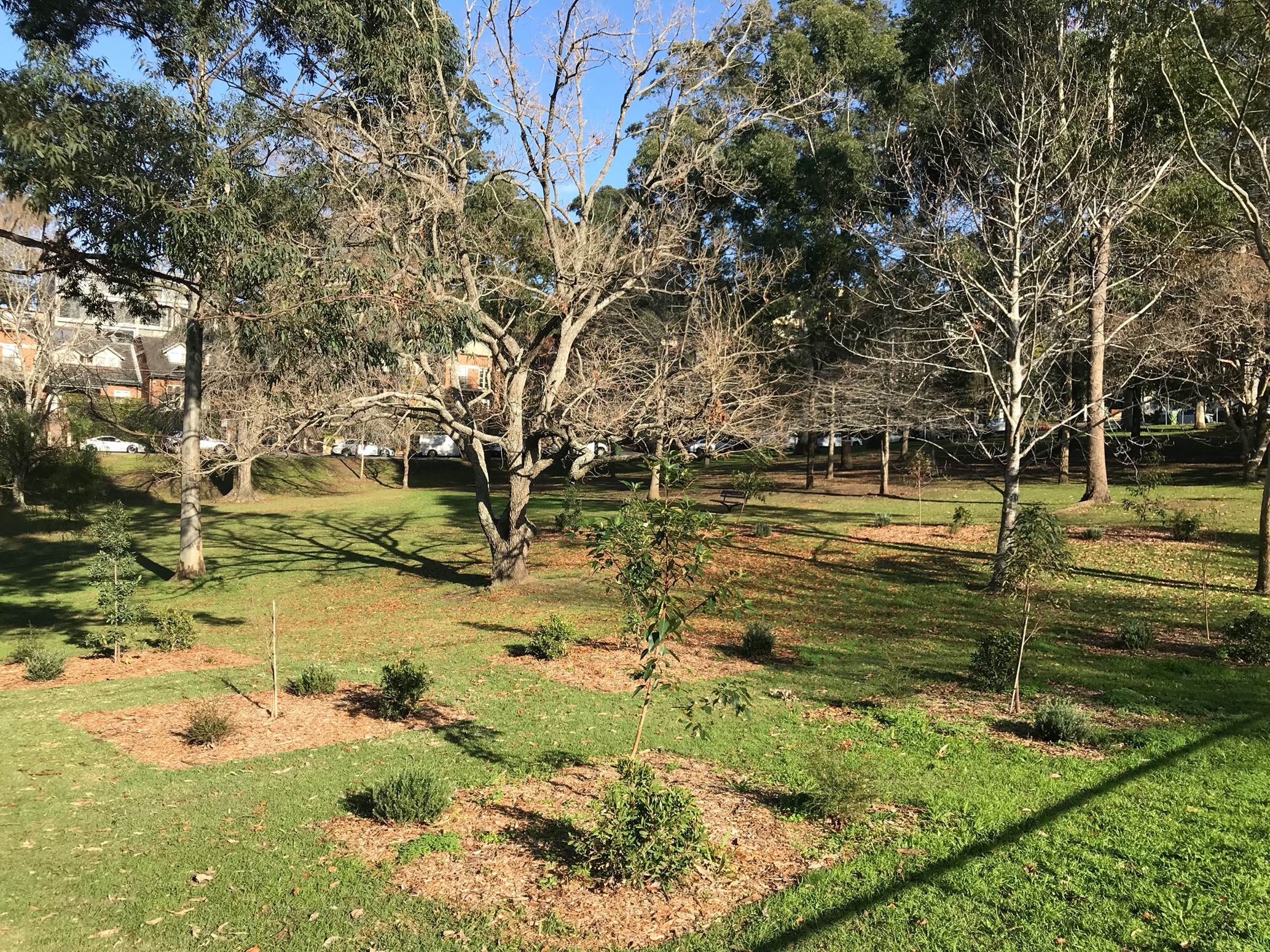
Ku-ring-gai, with its high rainfall, ridgelines capped with rich shale soils, and steeply incised sandstone valleys, has evolved a special tall forest character, which is one of the defining and valued characteristics of the area. Ku-ring-gai’s Urban Forest has changed over time but has kept extensive bushland within gullies, leading to scattered remnant vegetation and bushland along ridgelines, including a significant number of threatened species and ecological communities.
Recently, Ku-ring-gai developed its Urban Forest Policy, recognizing Ku-ring-gai’s Urban Forest as a valuable resource with significant economic, environmental, and social benefits, and intrinsically linked to Ku-ring-gai’s cultural integrity and character. The Urban Forest planning and management of this council provides for the protection and enhancement of remnant vegetation, bushland, and biodiversity. Under this goal, Ku-ring-gai joined Western Sydney University for the establishment of its Which Plant Where Living Lab site at Robert Pymble Park.
The addition of this site to the Which Plant Where Living Lab network is a great accomplishment for the local council and Western Sydney University. More greenery is needed in our cities for healthy minds, healthy bodies, and a healthy environment. This site will provide valuable information regarding species performance to ensure that future plantings are made with trees and shrubs that can tolerate the climate conditions that will occur in the near future.
Shepparton City Council Living Lab

Greater Shepparton City Council manages around 37,000 street and park trees in urban areas including Shepparton, Mooroopna, Tatura, Dookie, Murchison, Kialla, and Toolamba. These trees are a core part of Greater Shepparton’s urban forest, which includes all urban trees, both public and private. Shepparton’s Urban Forest Strategy sets a vision, objectives, targets, and a series of actions for the Council to adopt and adhere to over the coming decades and provides a framework for existing tree management, technical guidelines, and precinct plans. The Urban Forest Strategy ties together existing priorities for the region such as health and wellbeing, liveability, climate change adaptation, biodiversity, and economic prosperity. A healthy, long-lived, and valued urban forest will make Greater Shepparton a great place to live and work.
The Urban Forest Strategy states that by 2037, the Council will increase the urban forest canopy cover in each town to 40% and reduce the number of vacant street tree sites to zero. These goals represent a great opportunity for collaboration to create more green spaces while contributing to our understanding of how plants respond to climate change. The Which Plant Where Living Lab in Shepparton was developed to address these objectives as a collaboration between Shepparton City Council and Western Sydney University. This is the first site to be established in Victoria and adds one more to the network, which currently has eight sites in NSW, one site in Queensland, and one site in the ACT.
Data collected from this site will provide insights on how the role of local environmental conditions (e.g. planting context, micro-climate, soil type) determines the performance of plants with different morphologies and growth forms and the benefits associated with urban greening.
Australian Capital Territory: Canberra Living Lab
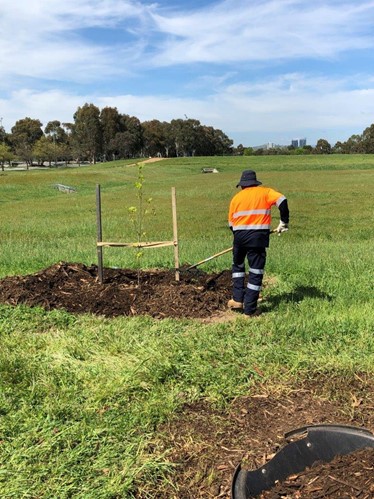
Canberra as a growing city has set a clear direction for the future in which trees will continue to have an important role. The Climate Change Strategy and Living Infrastructure Plan, both released in September 2019, set a tree canopy cover target of 30% by 2045. Achieving this target will involve changes to the way the ACT Government manages its urban forest, including trees both on public land and on leased land.
Across the ACT, 25,000 trees will be planted by 2023 to enhance our urban forest and the Canberra community has been helping identify where they should go. In Autumn 2020, over 4,000 trees were planted, including a new site of the Which Plant Where Living Lab, the first in this territory.
The Which Plant Where Living Lab was established at Evatt, a suburb in the Belconnen district of Canberra as part of the collaboration between ACT Government and Western Sydney University. This site will provide information about species growth and performance under different growing conditions across Australia. Currently, there are 12 sites in the Which Plant Where Living Lab network. Data collected from these sites will help to identify what sorts of plant species will thrive in our future cities, as well as to measure the co-benefits they provide to urban populations, such as attracting biodiversity. Furthermore, this site will contribute to the ACT Government’s vision for a resilient and sustainable urban forest that supports a liveable city and contributes to the wellbeing of the community in a changing climate.

